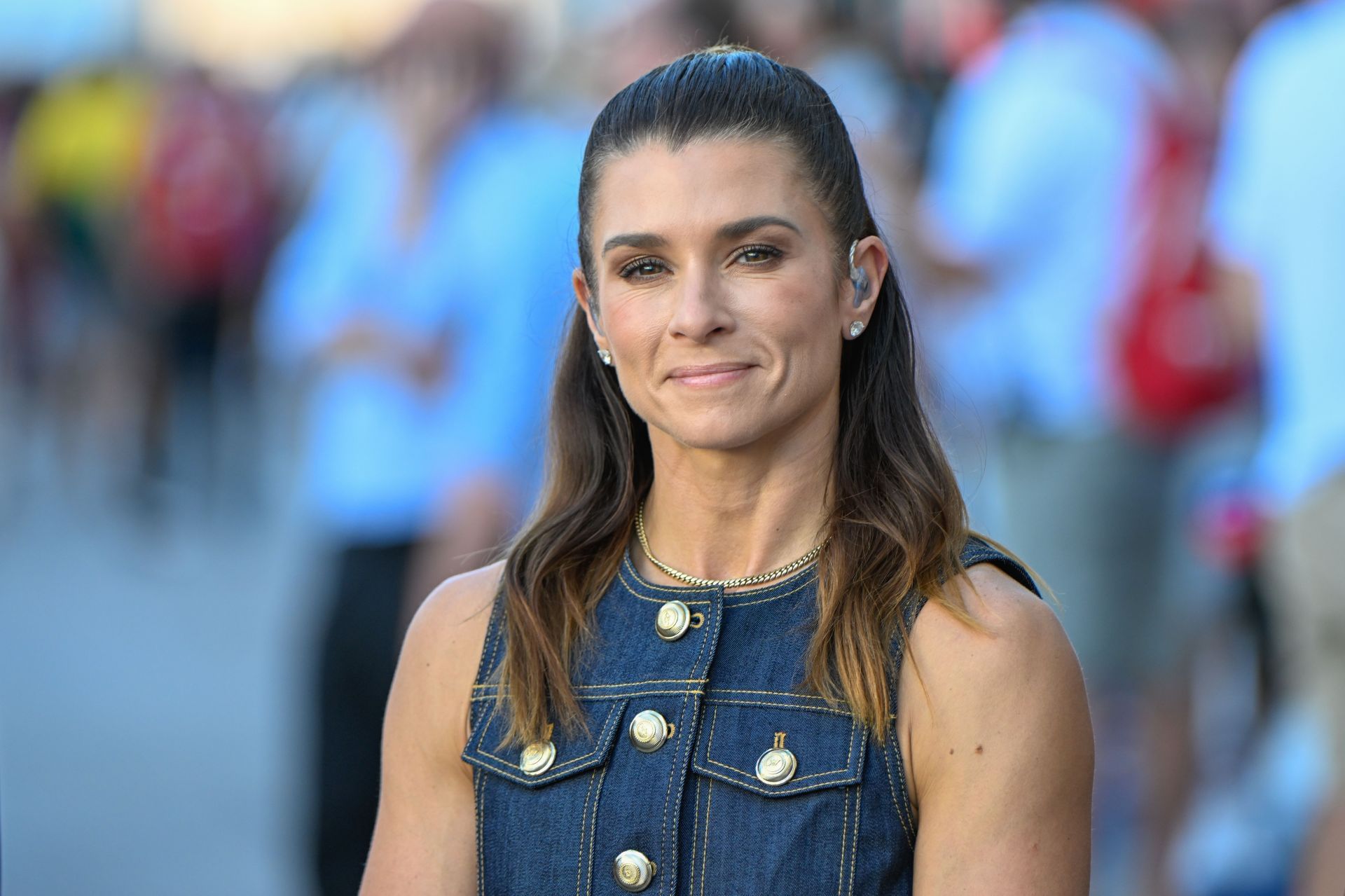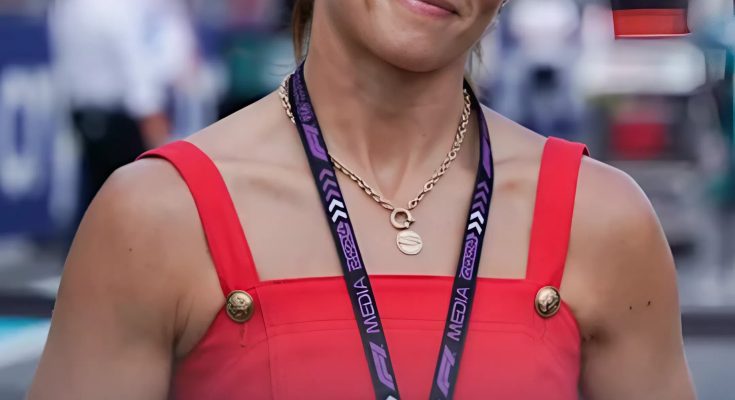🏎️ From Applause to Outrage — A Broadcast Gone Sideways
The U.S. Grand Prix weekend was supposed to be a celebration — a glittering showcase of speed, spectacle, and star power.
But somewhere between the checkered flag and the podium, a familiar name found herself trending worldwide for all the wrong reasons.
Danica Patrick, one of the most recognizable women in motorsport, was back on screen — this time not behind the wheel, but behind the microphone, as part of the F1 broadcast team for the Austin race.
What should have been a proud moment for American motorsport quickly spiraled into one of the most heated fan debates of the Formula 1 season.
And the irony? It wasn’t about what Danica said — it was about how she said it.
🎙️ The Comment That Sparked a Firestorm
It started innocently enough.
During post-race coverage, Patrick and her co-host were analyzing driver performances — particularly the ongoing battle between Lewis Hamilton, Max Verstappen, and Lando Norris.
But when Danica delivered her take on Hamilton’s strategy, fans immediately noticed something off.
“You can’t just keep blaming the car forever,” she said with a sharp tone and a smirk. “At some point, the driver’s got to deliver.”
The comment itself wasn’t shocking — in fact, it echoed sentiments many pundits have expressed before.
But the delivery — cold, clipped, almost dismissive — set social media ablaze.
Within minutes, F1 Twitter exploded.
“Why does she sound like she’s mocking him?” one fan posted.
“She says it like she’s scolding a kid,” another added.
“Her tone is the problem, not the point.”

In less than an hour, #DanicaPatrick and #USGPBroadcast were trending globally.
💥 The Internet Reacts: Fans Divided, Tempers High
As the clip spread, opinions split down the middle.
Some fans defended her blunt analysis:
“She’s a racer. She’s not sugarcoating it — and that’s why we need her on air.”
Others accused her of being condescending, biased, and “disrespectful” toward Hamilton, especially given his legacy and achievements in the sport.
One viral tweet, with over 50,000 likes, summed it up:
“Danica Patrick has every right to give her opinion. But the way she said it — that smug, dismissive tone — is exactly why fans feel alienated. Respect the drivers, even if you disagree.”
The replies were chaos.
Some called her “fearless.” Others called her “arrogant.”
And somewhere in between, Danica Patrick had become the headline of the U.S. Grand Prix — without ever turning a wheel.
Why Fans Took It Personally
To understand the outrage, you have to understand who Danica Patrick is — and what she represents.
She’s a pioneer. The first woman to win an IndyCar race. The face of female empowerment in motorsport. A groundbreaker who opened doors for others.
But that history comes with weight — and with scrutiny.
“When Danica talks, people don’t just hear a broadcaster,” said Motorsport.com columnist Rachel Brooks. “They hear the voice of the first woman to challenge a male-dominated sport. That voice carries power — and tone matters.”
In a sport already battling cultural divides — between Europe and America, old guard and new fans, tradition and showbiz — her delivery came off as dismissive to many.
It wasn’t just a tone; it felt like a statement.
🔥 A Familiar Pattern: When Women Speak, the World Listens Differently
There’s another layer to the controversy — one that goes beyond the track.
Critics pointed out that Danica Patrick was being judged more harshly for her tone than male broadcasters who regularly use sarcasm or cutting analysis.
“If Martin Brundle said the same thing, people would call it ‘savvy insight,’” wrote ESPN’s Max Foster. “When Danica says it, it’s suddenly ‘disrespectful.’”
Others pushed back, arguing this wasn’t about gender — it was about delivery and timing.
“She looked like she was enjoying the jab,” one fan commented. “There’s a fine line between analysis and attitude.”
Either way, the debate grew louder — and more personal.
💬 Danica Responds: “I’m Not Here to Please Everyone”
After two days of silence, Danica Patrick finally addressed the backlash during an interview with Sky Sports F1 Digital.
Her response? Calm, direct, and unapologetic.
“I’m not here to please everyone,” she said. “I’m here to share insight from my experience. Sometimes truth sounds harsh — that’s not disrespect, that’s reality.”
She went on to explain that her comments were aimed at performance accountability, not personal attacks.
“I’ve been on both sides — the driver and the analyst,” she added. “You don’t grow by being coddled. You grow when people tell you the hard truths.”
That statement — confident and composed — only added fuel to the fire.
Fans who had defended her doubled down.
Critics accused her of “doubling down on arrogance.”
And just like that, the drama evolved from a single soundbite to a full-blown debate about ego, gender, and sports culture.
🏁 The F1 Community Weighs In
Even F1 insiders couldn’t stay quiet.
Former driver Jenson Button weighed in during a podcast appearance:
“I think Danica’s right in principle — drivers have to take responsibility. But tone is everything on live TV. You’ve got to read the room.”
Meanwhile, Sky F1 commentator David Croft came to her defense:
“Danica tells it how it is. She’s a racer first, broadcaster second — and maybe that’s why it hits differently.”
Behind the scenes, network producers reportedly stood by her, calling the controversy “overblown.”
But the numbers don’t lie:
The broadcast segment featuring Danica’s comment became the most replayed moment of the US GP weekend on YouTube — surpassing even Verstappen’s podium celebration.
⚡ Why This Moment Matters
Beyond the memes and hot takes, Danica Patrick’s viral moment reveals something deeper about sports media in 2025.
Audiences today don’t just consume commentary — they feel it.
Tone, emotion, and authenticity matter as much as analysis.
“Fans want honesty, but they also want empathy,” said sports media analyst Claire Bennett. “Danica delivered honesty — without softness — and that shocked people more than it should have.”
Activewear
It’s the paradox of modern broadcasting:
Speak your truth, but smile while you do it.
💭 Final Thoughts: The Double-Edged Sword of Truth
At the end of the day, Danica Patrick didn’t say anything untrue.
She didn’t insult anyone directly. She didn’t use inappropriate language.
She simply spoke like someone who’s been in the fire — and maybe forgot that most viewers haven’t.
“When you’ve fought your way through IndyCar and NASCAR, you don’t sugarcoat,” said former driver Jamie Little. “That’s just who Danica is.”
Whether you love her or hate her, she did what few broadcasters manage to do:
She made the entire sport stop and listen.
And that, in the fast-moving world of Formula 1, is its own kind of victory. 🏁🔥




